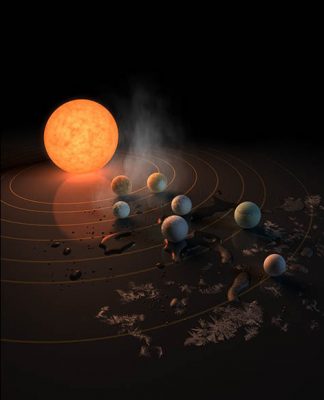Reprinted from the Island Free Press
NASA recently announced the discovery of seven Earth-size exoplanets orbiting TRAPPIST-1, which is a star and planetary system initially discovered using the TRAnsiting Planets and PlanetesImals Small Telescope.
Supporter Spotlight

Scientists think all seven are rocky planets, based upon their measured densities. Scientists believe it is possible that all of them could have liquid water, but three are in the habitable “Goldilocks Zone.” That means the orbits are in a range that’s not too hot and not too cold for liquid water. Liquid water is considered essential for the development of life as we know it.
TRAPPIST-1 is about 40 light-years from Earth. That means a spacecraft traveling at 52,000 mph would take more than 500,000 years to reach the exoplanet orbiting it.
I recently had a neat experience. At about 9:15, I stepped out of the observatory for a minute. As I opened the door, I saw the shooting star of a lifetime – a fireball that streaked down toward the western horizon burning out after two or three seconds. The fireball itself was brighter than Venus.
I reported the occurrence to the American Meteor Society and found out I wasn’t the only person who saw it.
Distant Galaxies
February also offered some very good opportunities to observe distant galaxies. My favorite image is this one of Messier 63, the Sunflower Galaxy.
Supporter Spotlight

The Sunflower Galaxy is 37 million light-years away. It’s a member of the M51 Group and has a visual magnitude of +9.3.
What to Look for in March
The sun set at 5:57 p.m. on March 1, with the moon, Mars, Venus and Uranus all just above the western horizon at sunset. With a magnitude of -4.6, Venus is very easy to spot. The moon is the only other object in the night sky that is brighter and it will be about 8 degrees above Venus. Mars and Uranus will appear very close to the moon. Mars is the red object you can see with the unaided eye and Uranus is the blue object you can’t see unless you’ve got a good pair of binoculars or a telescope.
Mars and Uranus will stay close to the western horizon throughout the month. Mars will seem to appear in the same area of the evening sky each night. Uranus will get closer and closer to the horizon with each passing day. By the end of the month, you will probably not be able to see Uranus, because the brightness of the setting sun will obscure the planet.
Venus will appear closer to the evening horizon with each passing day. Then, starting on March 20, you will be able to see Venus in both the evening and morning. Venus will set at 7:56 p.m.; the sun sets at 7:13 p.m. and rises at 6:45 a.m., just before sunrise at 7:03. This dual role as evening and morning star will be short-lived. Don’t expect to see Venus in the evening skies after March 24.
Mercury will start to be visible in the western skies starting around the middle of the month. It will appear higher above the western horizon each evening until early April. This makes the end of March an excellent opportunity to observe this small planet.
Jupiter rose in the east at 9:04 p.m. on March 1. Spica rises right after it, slightly to the south. The pair will continue to appear together throughout the month.
Saturn began the month rising at 2:14 a.m. By the end of the month, it will rise at 1:21 a.m.
If the skies are very clear and very calm, you might be able to see Canopus, the second-brightest star in the night sky, during the first part of the month. It will appear near the southern horizon almost directly beneath Sirius, the brightest star in the sky. If you have never heard of Canopus, try reading “Dune” by Frank Herbert. Arrakis, also known as “Dune,” is the third planet orbiting Canopus. If you don’t have time to read the book, you might like the movie. I have not found any evidence of any exoplanets orbiting this star.
Moon phases:
- First Quarter: March 5
- Full moon: March 12
- Last Quarter: March 20
- New moon: March 27
Learn More
This story is provided courtesy of the Island Free Press, a digital newspaper covering Hatteras and Ocracoke islands. Coastal Review Online is partnering with the Free Press to provide readers with more environmental and lifestyle stories of interest along our coast. You can read other stories about Hatteras and Ocracoke here.








